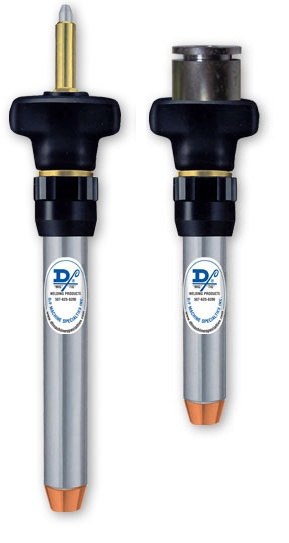
Series A High Capacity Barrels
(11/16"-1" Gas Cup ID)
Drawings Accessories More Info
Overview
The fully Water-Cooled-to-the-Tip® Robotic MIG (GMAW) Torch Models NCM-W/C-T & HTM-W/C-T are applied to a Direct Mount Docking Spool® for high current single arc welding. These robotic torches are fully water cooled internally and externally. The internal body of the torch is water cooled, thus putting the water cooling on the tip. This has increased tip life up to 14 times longer. Also, because the water cooling is on the tip, this enables customers to use our less expensive 122 slip-in copper tips for many applications. The exterior water cooled nozzle is internally water cooled as well. There are no bulky external water lines in the way leading down getting caught or getting damaged by heat. Because of the superior internal and external water cooling of this torch, you can run the full range of wires from .030"-1/8", whether your job is aluminum, steel, stainless steel, hard, cored, flux cored, stellite or inconel wire, whether your job has 1000 degree preheat, high deposition or continuous duty cycles, this is the torch. Very similar in design to the Linde ST12, Guild ST12, and Abicor Binzel AUT 750 but with improvements and new features, and proven to be a superior replacement alternative for the Linde HW13, or now called the ESAB HW13, the D/F Machine Water-Cooled-to-the-Tip® Robotic Torches are designed to provide long trouble-free service. These Automatic Water-Cooled-to-the-Tip® Torches are available in 5" and 8" lengths. Each length is available with our standard size nozzles (1.125"), and our high capacity (series A) nozzles (1.445") for more gas coverage. You can switch between the standard nozzles and high capacity nozzles if you have the correct inner parts for each. With the various models available a contact assembly selection may be made to suit individual robot torch requirements.
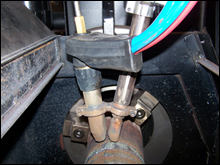 The fully Water-Cooled-to-the-Tip® direct mount Docking Spool® MIG (GMAW) automatic models NCM-W/C-T & HTM-W/C-T machine torches are for high current single arc welding. These torches are very similar in design to the Linde ST12, ESAB ST12, Guild ST12 and Abicor Binzel AUT 750 but with improvements and new features, and proven to be a superior replacement alternative for the Linde HW13, or now called the ESAB HW13, machine welding torch, and easily connects to the Linde MIG 35 or ESAB MIG 35. These torches can also be connected to subarc machines and used for MIG and sub arc on Lincoln Electric NA-5 & NA-5R submerged arc wire feeders with K148A & K148B torches, or on Miller sub-arc machines with OBT 600 & OBT 1200 torches. The D/F Machine Automatic Water-Cooled-to-the-Tip® positive contact assemblies are designed to provide long trouble-free service. These Automatic Water-Cooled-to-the-Tip® Torches are available in 5" and 8" lengths. Each length is available with our standard size nozzles (1.125"), and our high capacity (Series A) nozzles (1.445") for more gas coverage. You can switch between the standard nozzles and high capacity nozzles if you have the correct inner parts for each. With the use of the D/F sub-arc nozzle thread seals (14871 for Standard Size nozzles & 14872 for High Capacity size nozzles) these heavy duty MIG water-cooled torches can be converted and used as sub arc torches. Because of the robust design of the torch and the water-cooling on the body, nozzle and tip, downtime and consumable cost can be greatly reduced in the submerged arc process (SAW). With the various models available, an automated MIG torch selection may be made to suit individual automated welding system requirements.
The fully Water-Cooled-to-the-Tip® direct mount Docking Spool® MIG (GMAW) automatic models NCM-W/C-T & HTM-W/C-T machine torches are for high current single arc welding. These torches are very similar in design to the Linde ST12, ESAB ST12, Guild ST12 and Abicor Binzel AUT 750 but with improvements and new features, and proven to be a superior replacement alternative for the Linde HW13, or now called the ESAB HW13, machine welding torch, and easily connects to the Linde MIG 35 or ESAB MIG 35. These torches can also be connected to subarc machines and used for MIG and sub arc on Lincoln Electric NA-5 & NA-5R submerged arc wire feeders with K148A & K148B torches, or on Miller sub-arc machines with OBT 600 & OBT 1200 torches. The D/F Machine Automatic Water-Cooled-to-the-Tip® positive contact assemblies are designed to provide long trouble-free service. These Automatic Water-Cooled-to-the-Tip® Torches are available in 5" and 8" lengths. Each length is available with our standard size nozzles (1.125"), and our high capacity (Series A) nozzles (1.445") for more gas coverage. You can switch between the standard nozzles and high capacity nozzles if you have the correct inner parts for each. With the use of the D/F sub-arc nozzle thread seals (14871 for Standard Size nozzles & 14872 for High Capacity size nozzles) these heavy duty MIG water-cooled torches can be converted and used as sub arc torches. Because of the robust design of the torch and the water-cooling on the body, nozzle and tip, downtime and consumable cost can be greatly reduced in the submerged arc process (SAW). With the various models available, an automated MIG torch selection may be made to suit individual automated welding system requirements.
Features
- Water Cooled Internally - Tip Recessed in Water Cooling
- Water Cooled Externally - Gas Cup Recessed in Water Cooling
- Up to 650 Amps Continuous Duty Cycle
- Up to 850 Amps Continuous with Dual Power Cables
- Adaptable to Any Wire Feeder or Power Source
- Withstands Preheat Upwards of 900 Degrees
Model Explanation
- NCM-W/C-T Series-A - Normal Duty, Collet Action (Slip-In Tip), Machine Barrel - Water-Cooled-to-the-Tip, High Capacity (Series A)
- HTM-W/C-T Series-A - Heavy Duty, Threaded Tip, Machine Barrel - Water-Cooled-to-the-Tip, High Capacity (Series A)
Model Specifications
| MODEL | CURRENT CAPACITY |
WEIGHT w/ 5" NOZ. (APPROX.) |
WEIGHT w/ 8" NOZ. (APPROX.) |
COOLING REQUIRED |
RECOMMENDED WIRE DIA. RANGE |
INSTRUCTION MANUAL |
|---|---|---|---|---|---|---|
| NCM-W/C-T | 450 amps | 3 lbs | 3.8 lbs | 3 quarts/min | .030"-5/32" Hard/Cored, 3/64"-1/8" AL |
599 |
| HTM-W/C-T | 650 amps | 3 lbs | 3.8 lbs | 3 quarts/min | .030"-5/32" Hard/Cored, 3/64"-1/8" AL |
|
| HTM-W/C-T (with Dual Power Cable) |
850 amps | 3 lbs | 3.8 lbs | 3 quarts/min | .030"-5/32" Hard/Cored, 3/64"-1/8" AL |
Barrel Dimensions
| MODEL | Length w/ 5" Nozzle | Length w/ 8" Nozzle | Diameter of W/C Nozzle |
|---|---|---|---|
| NCM-W/C-T A, HTM-W/C-T A | 9.25" | 12.25" | 1.445" |
Ordering Information (Complete Assemblies)
| DESCRIPTION | CODE NO. (NCM) | CODE NO. (HTM) |
|---|---|---|
| Series A5" Nozzle | 40136 | 40248 |
| Series A8" Nozzle | 40137 | 40249 |
| Add Footage Digit to Item Code Number for Length Required. Example: Require 40137 with 4 Ft. Water-In Hose Assembly: 40137-4 | ||
Manuals & Downloads
Instruction Manuals
| TORCH MODELS | DOWNLOAD |
|---|---|
| NCM-W/C-T A, HTM-W/C-T A | 599 |
CAD Files & Drawings
| TORCH MODELS | CODE NO. | CAD FILE | PDF DRAWING |
|---|---|---|---|
| NCM-W/C-T A5" | 40136 | 40136 | 40136 |
| HTM-W/C-T A5" | 40248 | 40248 | 40248 |
| NCM-W/C-T A8" | 40137 | 40137 | 40137 |
| HTM-W/C-T A8" | 40249 | 40249 | 40249 |
Other Documents
| DESCRIPTION | DOWNLOAD |
|---|---|
| Choosing the Proper Chiller for Your Application |
|
| Torch Connection Options | |
| W/C Direct Mount Water-Cooled-to-the-Tip® One-Sheet |
Utility Station #45196
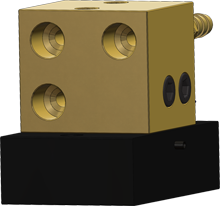 The D/F Utility Station is required for all D/F torch installations. Typical modern torch setups utilize a unitized cable assembly with a power pin. D/F torches take an alternative approach to the setup. The torches use a separate gas hose, water-in hose, Water Out & Power Cable, and casing/conduit. When one cable goes bad it is simply replaced instead of attaching an entire new unitized cable assembly; a huge cost saver! This is also where the D/F Utility Station comes into play. The gas hose, water-in hose, and Water Out & Power Cable are interfaced with the customer's existing lines via the Utility Station. The D/F torch leads plug into the front (see right) of the Utility Station. Into the back (see below) of the Utility Station go the customer's utilities. Read more on the D/F Utility Station product page.
The D/F Utility Station is required for all D/F torch installations. Typical modern torch setups utilize a unitized cable assembly with a power pin. D/F torches take an alternative approach to the setup. The torches use a separate gas hose, water-in hose, Water Out & Power Cable, and casing/conduit. When one cable goes bad it is simply replaced instead of attaching an entire new unitized cable assembly; a huge cost saver! This is also where the D/F Utility Station comes into play. The gas hose, water-in hose, and Water Out & Power Cable are interfaced with the customer's existing lines via the Utility Station. The D/F torch leads plug into the front (see right) of the Utility Station. Into the back (see below) of the Utility Station go the customer's utilities. Read more on the D/F Utility Station product page.
For more information on proper use of the D/F Utility Station, and to see the various torch connection options, please download the Torch Connection Options one-sheet.
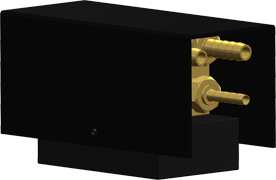
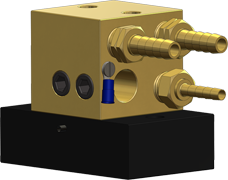
Water-Cooled-to-the-Tip® Torches - More Information
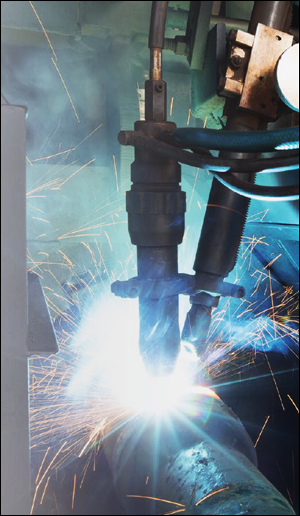 These D/F torches are very robust in design and fully water-cooled to the tip inside and out. This means that the contact tip is actually in the water-cooling, increasing contact tip life up to 7-to-1. The copper gas cup is also threaded into the front water-cooled nozzle assembly, potentially increasing its life to several months. The great increase in consumable life results in an equally great decrease in costs and downtime.
These D/F torches are very robust in design and fully water-cooled to the tip inside and out. This means that the contact tip is actually in the water-cooling, increasing contact tip life up to 7-to-1. The copper gas cup is also threaded into the front water-cooled nozzle assembly, potentially increasing its life to several months. The great increase in consumable life results in an equally great decrease in costs and downtime.
Another great feature of these torches is the fact that they have a slip-in tip, so if you have a burn back you are not dealing with all the hassle of a threaded tip. The welders love the slip-in tip! With the use of the D/F collet wrench, all you have to do is loosen the collet one half turn to remove the tip. It is not necessary to remove a gas cup in order to remove a tip. Upon getting a burnback, loosen the tip one half turn, run it a couple inches out of the torch, cut the wire with a wire cutter, put in the new tip, and begin welding again; it is that easy. With the slip-in tip you will have none of the struggles as with a threaded tip, and there is no need for removing the gas cup and using a bolt cutter or hack saw. Since the majority of hardbanding is done with 1/16” wire, most people, if not all, are below 500 amps, and because of our superior water cooling on the tip, the inexpensive slip-in tip will do a great job on 1/16” wire at those amperages. If higher amperages and larger wire sizes are needed, a heavy duty CrZr threaded tip is also available. These Water-Cooled-to-the-Tip® hardbanding guns and hardbanding torches are the most robust hardbanding welding guns in the industry.
Each D/F Automatic Welding Torch head is fully assembled and ready to install. In order to make the installation complete, the code number, wire size, make/model Automated Welding System (Thermadyne Thermal Arc Wire Feeders, Lincoln wire feeders, Miller wire feeders, Linde/ESAB wire feeders), and inlet as needed must be specified when ordering. If special welding tools or accessories other than those listed previously are required, please consult with the factory. Get the right feeder adapter connection to fit your MIG wire feeder.
Hardbanding Torches
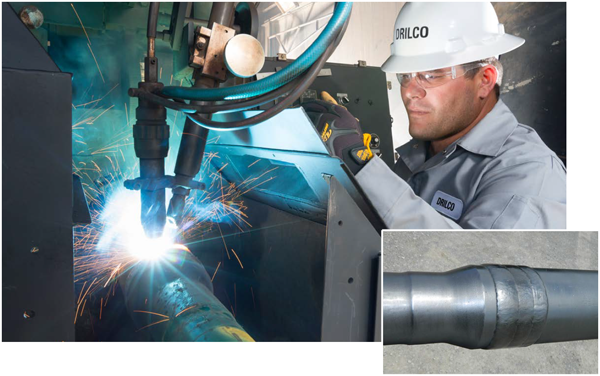
Hardbanding is the process of depositing hardfacing alloys onto drill pipe casing tool joints, collars and heavy weight pipe in order to protect both the casing and drilling assets from wear associated with drilling practices. Hardbanding is most commonly applied to the box end of drill pipe tool joints using a MIG welding process, bonding the hardbanding alloy with the parent steel of the drill pipe. There are, however, other hardbanding application methods that are occasionally used including laser and plasma arc processes.
The need for steel repair services arose decades ago when drilling contractors and operators wanted a way to protect and extend the life of costly drill pipe and tool joint material from the wear associated with rotational and axial friction forces while drilling and tripping in and out of a well. Initially, tungsten-carbide particles were dropped into a mild-steel matrix, remaining the industry standard used for many years. However, well owners soon realized that while the tool joint was virtually free of wear, the tungsten-carbide based hardbanding was causing extreme rates of wear and occasional total failure of the well casing. The goal for the hard banding industry became clear: create a hardbanding alloy that is casing-friendly while providing adequate protection of the tool joints.
Since that time, the market has become increasingly competitive and newer, more metallurgically advanced alloys have been introduced that protect casing and drill string assets better than ever. As wells are being drilled further, faster and more directionally, new challenges arise for hardbanding alloy producers. Competitive hardbanding products must now be able to protect drilling and casing components, but also withstand increasing extreme pressures and temperatures experienced in wells today. "Staying ahead of where drilling is going" is a mantra that every hardbanding producer will have to follow in order to stay competitive. Research is producing valuable and telling results that is enabling companies to improve their existing products, as well as, work towards introducing new and innovative hardfacing alloys to protect drill pipe and casing assets like never before. These Water-Cooled-to-the-Tip® hardfacing guns and hardfacing torches are the most robust hardfacing welding guns in the industry.
As drills go deeper and the hardbanding industry stedily evolves, D/F Machine Specialties strives to meet the assocaited demands by selling quality MIG welding products for your hardbanding needs. Our Automatic MIG Water-Cooled-to-the-Tip® Machine Torches and our Open-Arc Water-Cooled Gasless Overlay Machine Torches are ideal for steel wire, stainless steel, hard, cored, flux cored, or stellite, 1000 degree preheat, high deposition or continuous duty cycles - these are the torches used by:
- ARC Equipment Repair - Leading Manufacturer for portable and in-house hardbanding equipment and repair of hardbanding equipment
- Hardbanding Solutions Europe - Manufacturer of Hardbanding Equipment
- Postle Industries - Hardbanding Solutions - Home of the Most Wear Resistant, Non-Cracking Casing Friendly Hardbanding on the Market
- CSI Inspection, LLC - Visual, Mag Particle, EMI, UT and Shear Wave Inspection Services with State of the Art Calibrated Equipment
- Smith Services (Schlumberger) - Hardbanding Solutions, Drilling Tools & Services
- Arnco - Wear Resistand Hardbanding Alloys for the Worldwide Petroleum Industry
- Coffey Mfg., LLC - Manufacturer for portable and in-house Hard Banding Equipment
Hardbanding solutions for your business - whether you are oil & gas operators, drilling contractors, pipe rental companies, pipe manufacturers, or hardband applicators, hardbanding will help you:
- Extend the life of tool joints
- Reduce the number of times the pipe is pulled for maintenance
- Provide faster re-application of hardbanding - 100% rebuildable
- Non-cracking minimizes problems of spalling and cracking
- Ease of application with minimal clean up
- Fast delivery means reduced inventory
- Easy re-application - 100% rebuildable without removing the previous hardbanding layers
Companies that use hardbanding solutions:
- British Petroleum
- Ensign Drilling
- Exxon Mobil
- Marathon Oil
- RDT
- Shell Exploration
- Transocean
- VAM
- Weatherford
Hardbanding Torches
What is hardbanding?
Hardbanding is the process of depositing a layer of super hard metal onto drill pipe tool joints, collars and heavy weight pipe in order to protect both the casing and drill string components from wear associated with drilling practices.
From the Petroleum Industry Glossary:
Hardbanding is the process of laying on a coating or surface of [super-hard metal] on a [softer metal part] at a point or on an area of severe wear or abrasion - putting a hard surface on a softer metal by welding or other metallurgical process. Where it may be impractical or prohibited by structural constraints to manufacture a part from the harder metal, hard-surfacing of the part is a practical solution. Hardbanding is the term given to hardfacing drill pipe – hardbanding is a specific form of hardfacing.
How is hardbanding applied?
Hardbanding is most commonly applied using a modified MIG welding apparatus designed specifically to apply hardbanding onto a tubular surface. With this process, a continuous consumable wire electrode and a shielding gas are fed through a welding torch. An electric arc transferred between the wire electrode and parent metal melts the hardbanding wire and forms a fully metallurgically bonded hardbanding weld overlay. There are, however, other hardbanding application methods that are occasionally used including laser and plasma arc processes.
How often does hardbanding have to be reapplied?
Depending on drilling conditions and hardbanding performance, hardbanding will have to be reapplied anywhere from several weeks to many months of service. Hardband re-application is a costly and time consuming process which usually involves transporting drill string components to inspection or other facilities that are capable of hardbanding operations. Mobile hardbanding units may also be deployed to or near drilling operations for on-site application. Use of these machines depends on the availability or supply of units offered in any given area.
What are the different types of hardbanding?
Hardband products can generally be divided up into two categories: Tungsten Carbide (non casing-friendly) and Casing Friendly hardband products. Casing friendly material can be metallurgically classified as “chromium-carbide”, “Titanium Carbide”, “Niobium Boride”, and other, based materials.
What is "cracking hardbanding", and why does it crack?
Cracking hardbanding describes a hardbanding product that exhibits what is referred to in the hardfacing world as “check relief cracking”. “Check relief cracking” occurs when low-melting phases form over grain boundaries as the molten weld puddle cools. In other words, a specific type of carbide forms on the grain boundaries of the microstructure that create stress as the material cools immediately after being deposited on the parent metal – as a result, fine cracks form. Hardfacing materials that exhibit cracking cannot be used for structural uses, though for abrasion or wear resistance they are widely acceptable, as in the case of hardbanding for tool joint and other drill string component applications.
What is Hardfacing?
Hardfacing is gaining more and more importance in the most varied fields of modern engineering. In the case of wear, corrosion and other types of surface attack, the application of hardfacing permits the economical reconditioning of many structural members. Reconditioning may comprise workpieces subjected to metal-to-metal wear such as rollers, crane wheels, shafts, rails or which are subjected to metal-to-mineral wear, like building machinery, conveyor screws, excavator bucket edges, etc.
The possibilities of hardfacing not only lie in the field of reconditioning, but more and also in the manufacture of new tools and components. In this manufacturing process, a non-alloyed or low-alloy steel is used as carrier material to which are imparted special properties by welding on a suitable high quality weld metal. Decisive factor in hardfacing is the knowledge of the wear conditions, that is, whether it is a frictional wear caused by metal or minerals, corrosion, cavitation, erosion or temperature. The selection of the welding consumable to be used will depend on these conditions. Besides this, it is most important to know the composition of the base metal to be surfaced, because of the measures likely to be taken, such as preheating and/or post weld treatment..
What are the Various Demands that Hardfacing will Satisfy?
Depending on the use of the workpiece to be hardfaced, the weld metal shall meet the most varied demands. These can be cited as follows:
In some cases, more than one of these modes of load may occur simultaneously, so that the weld metal must posses the respective properties. Hence, a conscientious selection of the proper weld metal will be a must. Of course, there doesn't exist a weld metal possessing all these properties in full measure. Nevertheless, in most cases it will be possible to find a satisfactory compromise in practice.
- Hardness in the As-Welded Condition
- Red Hardness under Thermal Loads
- Resistance to Metal-to-Metal Wear
- Abrasion Resistance to Frictional and Grinding Wear
- Impact Strength
- Corrosion Resistance
- Resistance to Scaling
How Can Hardfacing be Used to Recondition Tools?
An interesting field of application in hardfacing is reconditioning of hardened tools, such as shear blades, punching dies, cutting edges, deep-drawing tools, etc. For this purpose, the so-called “step hardening weld method” has proven a success. Welding is carried out in the delayed transformation range which is situated between the perlite and bainite zones of TTT-curves of the steel in question. Thereby, the hardenability of the steel is taken into account. Generally, the temperature range in which welding shall be carried out is from 400°C to 600°C. This means, that step welding is based on the fact that in such steels the transformation of austenitic is clearly delayed within a certain temperature range. The sequence of operations is as follows:
- Slow heating of the workpiece to its hardening temperature. At this temperature the structure becomes austenitic.
- Cooling to step temperature; that is, to the range in which the delay in austenitic transformation (according to TTT-diagram) is most pronounced.
- Welding the workpiece at this temperature.
- Cooling the workpiece to room temperature in still air or better in oil (50°C to 150°C).
- Tempering to the respective temperature which in the case of high-speed steels lies in the range of 550°C to 570°C.
- Machining the weld area.
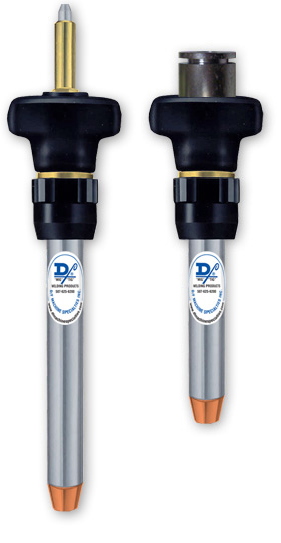
Standard Barrels
(7/16"-3/4" Gas Cup ID)
Drawings Accessories More Info
Overview
The fully Water-Cooled-to-the-Tip® Models NCM-W/C-T & HTM-W/C-T Direct Mount Automatic Machine Torches offer the same features as those described for the machine barrels above. These torches feature the 1.125" smaller O.D. water-cooled nozzle for hard-to-reach, limited access areas. Very similar in design to the Union Carbide Linde ST-12, ESAB ST-12, Guild ST-12, and Abicor Binzel AUT 750 but with improvements and new features, and proven to be a superior replacement alternative for the Linde HW-13, or now called the ESAB HW-13, machine welding torch, the D/F Machine Automatic Water-Cooled-to-the-Tip® positive contact assemblies are designed to provide long trouble-free service. These D/F heavy duty water-cooled weld automation torches are ideal and have been used for metal build up, hard banding, hard facing, metal spray applications, and pipeline construction, or even retrofit with a flux delivery system for sub arc applications, and applications where carbide is added.
The direct mount fully Water-Cooled-to-the-Tip® Docking Spool® accommodates two (2) water-cooled nozzle assemblies. This arrangement is readily adaptable to dedicated or automatic welding applications such as the Lincoln Electric NA3, NA4, NA5, NA5R, Power Feed 10, LF72, LF74 automatic wire feeders, Miller series power pins, ESAB, Euro and Tweco #4. The equipment consists of four (4) basic components: a Utility Station, an intermediate Utilities Combination assembly, a High Deposition Docking Spool®, and a Water Cooled Nozzle. The Docking Spool® is the principal component in this welding equipment arrangement. It accepts the utilities at the top end of the Docking Spool® and provides a means of accepting the water cooled nozzle at the lower end with superior water cooling. Several features important to a welding system are provided. Incorporated within the water channels of the Docking Spool® are check valves which provide a means of retaining residual water in the lines when the nozzle assembly is removed from the Docking Spool®. In addition a POSIT® Ring is provided at the upper end of the Docking Spool® which allows positive location in a mounting bracket to maintain dimensional stability.
Features
- Water Cooled Internally - Tip Recessed in Water Cooling
- Water Cooled Externally - Gas Cup Recessed in Water Cooling
- Up to 650 Amps Continuous Duty Cycle
- Up to 850 Amps Continuous with Dual Power Cables
- Adaptable to Any Wire Feeder or Power Source
- Withstands Preheat Upwards of 900 Degrees
Model Explanation
- NCM-W/C-T - Normal Duty, Collet Action (Slip-In Tip), Machine Barrel - Water-Cooled-to-the-Tip
- HTM-W/C-T - Heavy Duty, Threaded Tip, Machine Barrel - Water-Cooled-to-the-Tip
Model Specifications
| MODEL | CURRENT CAPACITY |
WEIGHT w/ 5" NOZ. (APPROX.) |
WEIGHT w/ 8" NOZ. (APPROX.) |
COOLING REQUIRED |
RECOMMENDED WIRE DIA. RANGE |
INSTRUCTION MANUAL |
|---|---|---|---|---|---|---|
| NCM-W/C-T | 450 amps | 2.8 lbs | 3.5 lbs | 3 quarts/min | .030"-5/32" Hard/Cored, 3/64"-1/8" AL |
599 |
| HTM-W/C-T | 650 amps | 2.8 lbs | 3.5 lbs | 3 quarts/min | .030"-5/32" Hard/Cored, 3/64"-1/8" AL |
|
| HTM-W/C-T (with Dual Power Cable) |
850 amps | 2.8 lbs | 3.5 lbs | 3 quarts/min | .030"-5/32" Hard/Cored, 3/64"-1/8" AL |
Barrel Dimensions
| MODEL | Length w/ 5" Nozzle | Length w/ 8" Nozzle | Diameter of W/C Nozzle |
|---|---|---|---|
| NCM-W/C-T, HTM-W/C-T | 9.25" | 12.25" | 1.125" |
Ordering Information (Complete Assemblies)
| DESCRIPTION | CODE NO. (NCM) | CODE NO. (HTM) |
|---|---|---|
| Standard 5" Nozzle | 40134 | 40246 |
| Standard 8" Nozzle | 40135 | 40247 |
| Add Footage Digit to Item Code Number for Length Required. Example: Require 40134 with 4 Ft. Water-In Hose Assembly: 40134-4 | ||
Manuals & Downloads
Instruction Manuals
| TORCH MODELS | DOWNLOAD |
|---|---|
| NCM-W/C-T, HTM-W/C-T (All 5" Nozzles) |
599 |
CAD Files & Drawings
| TORCH MODELS | CODE NO. | CAD FILE | PDF DRAWING |
|---|---|---|---|
| NCM-W/C-T 5" | 40134 | 40134 | 40134 |
| HTM-W/C-T 5" | 40246 | 40246 | 40246 |
| NCM-W/C-T 8" | 40135 | 40135 | 40135 |
| HTM-W/C-T 8" | 40247 | 40247 | 40247 |
Other Documents
| DESCRIPTION | DOWNLOAD |
|---|---|
| Choosing the Proper Chiller for Your Application |
|
| Torch Connection Options | |
| W/C Direct Mount Water-Cooled-to-the-Tip® One-Sheet |
Utility Station #45196
 The D/F Utility Station is required for all D/F torch installations. Typical modern torch setups utilize a unitized cable assembly with a power pin. D/F torches take an alternative approach to the setup. The torches use a separate gas hose, water-in hose, Water Out & Power Cable, and casing/conduit. When one cable goes bad it is simply replaced instead of attaching an entire new unitized cable assembly; a huge cost saver! This is also where the D/F Utility Station comes into play. The gas hose, water-in hose, and Water Out & Power Cable are interfaced with the customer's existing lines via the Utility Station. The D/F torch leads plug into the front (see right) of the Utility Station. Into the back (see below) of the Utility Station go the customer's utilities. Read more on the D/F Utility Station product page.
The D/F Utility Station is required for all D/F torch installations. Typical modern torch setups utilize a unitized cable assembly with a power pin. D/F torches take an alternative approach to the setup. The torches use a separate gas hose, water-in hose, Water Out & Power Cable, and casing/conduit. When one cable goes bad it is simply replaced instead of attaching an entire new unitized cable assembly; a huge cost saver! This is also where the D/F Utility Station comes into play. The gas hose, water-in hose, and Water Out & Power Cable are interfaced with the customer's existing lines via the Utility Station. The D/F torch leads plug into the front (see right) of the Utility Station. Into the back (see below) of the Utility Station go the customer's utilities. Read more on the D/F Utility Station product page.
For more information on proper use of the D/F Utility Station, and to see the various torch connection options, please download the Torch Connection Options one-sheet.


Torch Rack #30418 and Rack Mount
An optional D/F Torch Rack #30418 can be used on any torch with an 8" long, 1.125" diameter water-cooled nozzle. The rack slips right over the water-cooled nozzle and is secured with 4 set screws. The rack can then be dropped into a BUG-O BUG-5188 Rack Holder. The rack has a 32 pitch gear, and with the rack holder makes torch head positioning very easy. See the images below right. See the Torch and Rack Mount product page for more information
For more information on proper use of the D/F Utility Station, and to see the various torch connection options, please download the Torch Connection Options one-sheet.
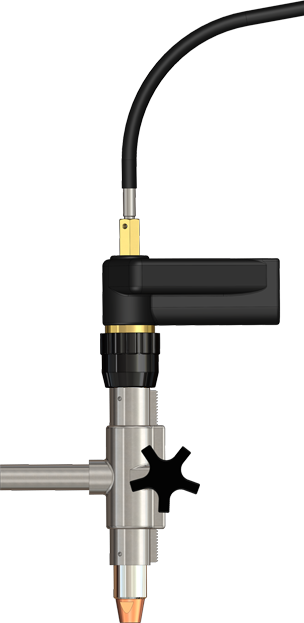
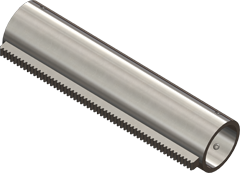
D/F #30421 Sub-Arc Attachment
The D/F Water-Cooled-to-the-Tip® Machine Barrels used with the D/F Submerged Arc Attachment are the industry's most advanced sub-arc torches for mobile, hard automation, and robotic feeding equipment, and will help achieve new levels of welding performance and operational efficiency. Whether your application is bridge decking, pressure vessels, panel line, seamers, pipe mill integrator solutions, or submerged arc robotic welding, the D/F sub arc choices are designed to improve weld quality, reduce welding and operational costs, and increase weld team productivity.
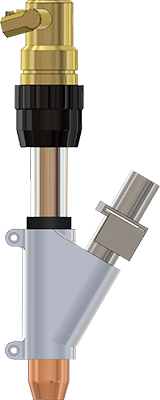
D/F Water-Cooled-to-the-Tip® - More Information
The D/F Water-Cooled-to-the-Tip® automatic Remote Mount and Direct Mount Machine Barrels are ideal for hardbanding applications. They are repareable and easy to maintain. Our consumables are always in stock and are 1/3 of the cost of competitiors'. Customers have been perpetually pleased to find out that we ship every order within 3 days of receipt of a purchase order, and that we are always willing to do our best to ship our equipment for next-day delivery.
The direct mount fully Water-Cooled-to-the-Tip® Docking Spool® accommodates two (2) water cooled nozzle assemblies. This arrangement is readily adaptable to dedicated or automatic welding applications such as the Lincoln Electric NA-3, NA-4, NA-5, NA-5R, Power Feed 10, LF-72, LF-74 automatic wire feeders, Miller series power pins, ESAB, Euro and Tweco #4. The equipment consists of four (4) basic components: a Utility Station, an intermediate Utilities Combination assembly, a High Deposition Docking Spool®, and a Water Cooled Nozzle. The Docking Spool® is the principal component in this welding equipment arrangement. It accepts the utilities at the top end of the Docking Spool® and provides a means of accepting the water cooled nozzle at the lower end with superior water cooling. Several features important to a welding system are provided. Incorporated within the water channels of the Docking Spool® are check valves which provide a means of retaining residual water in the lines when the nozzle assembly is removed from the Docking Spool®. In addition a POSIT® Ring is provided at the upper end of the Docking Spool® which allows positive location in a mounting bracket to maintain dimensional stability.
The W/C Tip Torches can run the complete line of D/F standard size C122 DHP contact tips and the complete line of D/F standard size CrZr (chromium zirconium) long-life contact tips, as well as any custom current tip configuration you may need. .030" (.8mm), .035" (.9mm), .045" (1.2mm), .052" (1.4mm), 1/16" (1.6mm), 3/64" (1.2mm), 5/64" (2mm), 3/32" (2.4mm), 1/8" (3.2mm) and other diameters.
W/C Tip D/F Machine Specialties torches are standard equipped with 1 water/out & power cable are rated at 650 amps (continuous duty cycles). These ratings are, however, dictated by the contact tip. The NCM (slip-in) series of contact tips is rated up to 450 amps (continuous duty cycles). If your welding application requires amperage above 450, you must change to the heavy duty threaded CrZr (chromium zirconium) series of contact tips.
These automatic machine welding assemblies are designated by torch models. The model NCM (slip-in Contact Tip) has a current capacity 450 amps in argon shielding. Like the ESAB ST-12, these accommodate slip-in current tips fastened by a collet action nut. The wire diameter range with hard wire is .030"-1/16", cored wire .035"-1/8", and aluminum wire range of .035"-3/32".
The torch model HTM (Threaded Contact Tip) has a current capacity range of 650 amperes. Rating will be contingent on the combination of current tip and shielding gas to be used. The model HTM employs threaded CrZr (chromium zirconium copper) current tips and will accommodate .030" - 1/16" hard wire, .035" – 1/8" cored wire and 3/64" - 3/32" aluminum wires.
In some instances C122 DHP is adequate, but for stainless steel and stiff, high column strength or abrasive wires such as flux cored / metal cored, CrZr is the correct choice. D/F Machine Specialties can increase several key characteristics creating a higher-quality consumable with increased conductivity, even higher softening temperature and improved hardness. This means a reduction in "arc start failures" and increased tip life. Copper chromium zirconium (CuCrZr) contact tips increase productivity.
W/C Tip model torches can also be retrofit to have 2 water/out & power cables increasing the continuous duty cycle rating to 850 amps. These amperage require the use of the HTM or threaded series of chromium zirconium (CrZr) current tips.
The D/F torch is famous for the fact, that if it is chilled properly, the welder can grab the chrome front water-cooled barrel (not the copper gas nozzle/cup) of the torch with their bare hand and it will be cold to the touch seconds after welding. With the proper chiller, this can be done even after a 4 hour arc time. Make certain the cooling water supply is at least the minimum flow rate of 1 gallon per minute (for each inner body), at 40 psi (80 psi maximum) with a 6 gallon reservoir and a recommended 30,000 BTU/hr cooling capacity. Gun ratings are affected by shielding gas used, arc time, cooling time and inlet water temperature. Water outlet temperature should not exceed 27°C (80°F). The torch’s water out & power cable is not cooled until the coolant has gone through the torch and out the water out & power cable. If water is not flowing through the D/F torch for at least 1 minute prior to striking an arc, when you apply the power and water hits the “hot” water/out & power cable, you will generate steam. Steam can damage the torches internals in seconds causing a leak. It can also blow out the torches water/out & power cable. A flow switch can be installed after the return line ensuring that coolant is present at the return line prior to striking an arc. When High-Deposition GMAW, high current density, high amperages, preheat, or extended periods of arc time are used, a refrigerated liquid chiller with a larger reservoir is required. Precise temperature control maintains the cooling at a constant 13°C (55°F) temperature, thus prolonging the life of the welding equipment and more specifically extending the service life of the gas nozzle and current tip. D/F Machine Specialties does not manufacture or sell chillers, we only recommend them. Click here to see our recommended chillers.
Fixed automation is a process that uses mechanized machinery to perform repetitive operations in order to produce a high volume of similar parts. In fixed automation, the sequence of processing operations is fixed by the equipment layout.
Programmable automation is an applied form of fixed automation that is capable of repeating motion, in a series of steps, for producing products in batches. Applied products in a programmable automation system are made in batch quantities ranging from several dozen to several thousand units at a time. For each new batch, the programmable automation equipment must be reprogrammed and changed over to accommodate the new product style. Programmable automation may commonly include one to three axes of torch motion and/or multiple welding arcs.
D/F Machine Specialties is the world leader in the manufacture of water-cooled torches for hard automation systems which encompasses fixed automation and programmable automation.
Each D/F Machine Specialties welding gun is fully assembled and ready to install. In order to make the installation complete, the code number, wire size, wire feeder make/model (Lincoln wire feeders, Miller wire feeders, Tweco wire feeders, ESAB wire feeders, & EURO Quick Disconnect wire feeders), and inlet (as needed) must be specified when ordering. If special welding tools or accessories other than those listed previously are required, please consult with the factory. Get the right feeder adapter connection to fit your MIG wire feeder.

